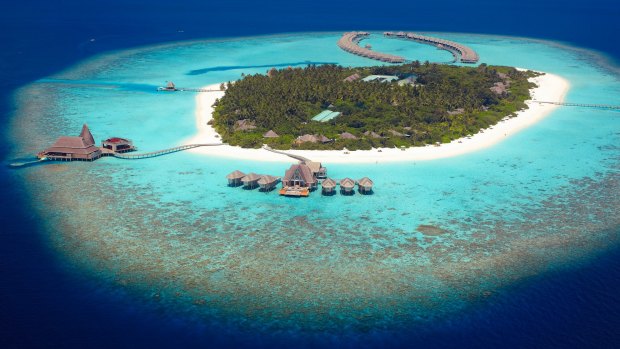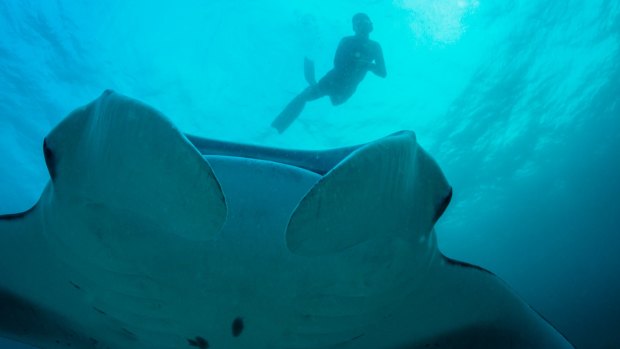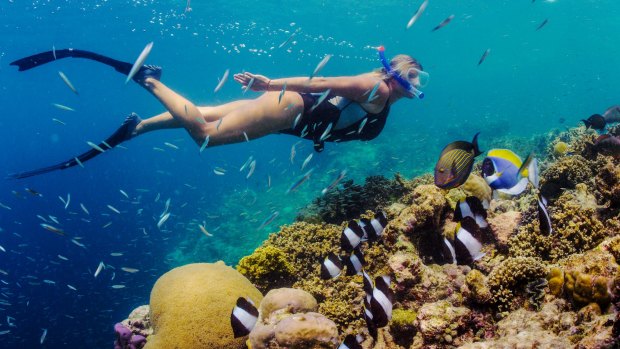By Keith Austin

Anantara Kihavah Maldives Villas on Kihavah Huravalhi Island.Credit: Sakis Papadopoulos
It happens all of a sudden. We slip into the clear, bath-warm waters of Hanifaru Bay in the Maldives, all colourful snorkels and flippers and excited expectation, and have just enough time to put our masks beneath the surface when a large manta ray appears off to the right.
Our last attempt to swim with manta rays took place in a tropical storm with grey sideways rain, grey choppy waves, pretty much zero visibility and the only sighting a partial glimpse of something grey and manta ray-shaped shooting off into the distance (presumably going to get an umbrella).
So, you know, we're pretty stoked to see just one of these amazing creatures in the wild.

Diving with manta rays.Credit: Dean Cropp @barefootcaptain
But hang on, it's not just one – there's another one behind it, and another one behind that, and … it's about now that I discover you can say "oh, my God" into a snorkel and not drown.
In the next few minutes I count (in between the swearing) 20 mantas in a single file. And that was only because I stopped counting – other members of our little dive group count 27 of them.
What happens next is anyone's guess. Do they turn around and come back for a sticky-beak? Is it another group? It's hard to say given one manta looks very much like the next but suddenly we're surrounded by them.

Snorkelling among schools of fish.Credit: Dean Cropp @barefootcaptain
Dean Cropp, an Australian underwater photographer and cameraman, dives down to get a better angle and I can only watch as they glide slowly past or turn barrel rolls in the water before him, as if they're performing for the camera.
He looks small and insignificant beside these magnificent, majestic creatures. We all do.
They glide gracefully through the water, flying rather than swimming. They are gentle giants, powerful but delicate, eating only plankton and the like, sieving them through the great open maw of their mouths as they slide in and around us without once touching.
We are in the water for 45 minutes – the maximum amount of time allotted for any manta ray encounter here – and they keep coming. At one point I am surrounded by them, some swimming towards me head on only to sashay aside at the last moment.
They look, with their diamond shapes, black and white markings and white underbellies, like giant kites made of rippling cow hide. I have to remind myself to breathe as they glide past in their dozens, often just centimetres away. I am not afraid – far from it.
It is awesome. And astonishing, astounding, inspiring, breathtaking, gob-smacking and pretty damn all round glorious. There aren't enough superlatives to do it justice. It is a once-in-a-lifetime event (for most of us) from which you come away moved, humbled, excited, saddened, joyful and in with a grin that takes days to fade.
Cropp, who has photographed manta rays several times before, says: "It's one of the best all-time epic manta ray experiences I have ever had let alone filmed … as soon as we jumped in we were eye to eye with 27 huge mantas feeding, playing and even doing backflips. I guess they were just as happy to see us, too."
As we get back on the Ocean Whisperer, the yacht that is going to take us on the 40-minute journey back to Anantara Kihavah Maldives Villas on Kihavah Huravalhi Island, we are all, without exception, grinning from ear to ear. There are stories of close encounters, of photographs taken or missed, of the size of the mantas and how their mandibles seemed to gather water in front of them and push it into their great open maws.
Me? I eventually retire to the front of the yacht by the bowsprit on my own and run the images through my mind's eye again and again. I know I'll probably never come this way again and I want to sear the encounter into my consciousness and never, ever forget.
The Maldives is unusual; it's a strict Muslim country where alcohol is banned but freely available in the resorts, and, for somewhere so famous, nobody seems to know where it is. Perhaps it's because it's so flat, mostly made of water and therefore easy to miss.
For the record, the Maldives is an Islamic republic in the Indian Ocean south-west of India. It is one of the world's most dispersed countries – essentially 1192 coral islands in a chain of 26 atolls.
It is 1 per cent land and 99 per centwater, spans 298 square kilometres and is as flat as a pancake. Its highest point above sea level (2.4 metres) is the world's lowest. At current rates of sea level rise, it's posited, the Maldives will be uninhabitable by 2100. This is not a place to go mountain climbing.
But while there are no mountains above sea level, there are plenty of them below – the Maldives is essentially the scattered summits of a vast submarine mountain range (the 960-kilometre long Chagos-Maldives-Laccadive Ridge).
Nowhere is this more evident than when flying into the resort from the capital, Male. Looking down on the coral reefs and sand bars in all their gold and turquoise glory, it's easy to see where the pale blues of the shallows drop off sharply down the mountainsides.
There's one such place on Kihavah Huravalhi, just a few metres off the stupidly luminous white sand beach by the water sports centre. Here, you can wade through waist-high, periwinkle blue water – startling the cute baby reef sharks that live here – to the point where the reef drops steeply off into the deep through ever-darker shades of blue.
One moment you can see the sandy bottom and the next you're soaring above an almost vertical wall of coral that disappears into vast nothingness. It's certainly not the place for anyone with vertigo or thalassophobia, that's for sure. For the rest of us, it's a fishy playground swirling with colour. Here, just a fingertip away, there are ever-so-elegant Moorish idols with their trailing crest, coral-nibbling parrotfish, pouting butterflyfish, and teeming, glittering balls of smaller fish for whom there's safety in numbers. Further down, mostly indistinct shapes in scuba diving territory, lurk what look like large wrasse, trevally, snapper or maybe a lone barracuda.
Anantara Kihavah Maldives Villas is on a coral island in the Baa Atoll archipelago. It can be circumnavigated by foot in about 30 minutes and is one of those ridiculously perfect luxury resorts you see on the ads, all palm trees over pristine beaches, tropical jungle, underwater dining and those spectacular wooden hut-style villas perched over transparent, powder-blue waters.
Oddly, the Maldives reminds me of Venice – one of those utterly preposterous places that really shouldn't exist. A place that, even when you're there with the sand between your toes and your eyes trying to make sense of the innumerable shades of blue from shoreline to horizon and beyond, doesn't seem real.
It's real enough for more than a million people to visit each year, though. And we're not all dreaming. Are we?
TRIP NOTES
MORE
STAY
Anantara Kihavah Maldives Villas is 30 minutes from Velana International Airport in Male, the capital, by seaplane. The island has 79 private pool villas ranging from 260-3000 square metres. They are either built over the water or tucked away with beach views and private beach access. See kihavah-maldives.anantara.com
FLY
Singapore Airlines flies to Male via Singapore. The first leg takes eight hours, followed by a four-hour hop to Male. Depending on arrival times, the last leg to the island will be by seaplane or a domestic flight to nearby Dharavandhoo Island followed by a 20-minute speedboat journey to Kihavah. See singaporeair.com
TRAVEL
No visa is needed before entering the Maldives. Thirty-day visas are issued on arrival provided your passport is valid for six months and you have a confirmation of reservation at a resort or hotel. Australia does not have an embassy or consulate in the Maldives. The Australian High Commission in Sri Lanka provides consular assistance to Australians in the Maldives. See smartraveller.gov.au
TOUR
The manta ray snorkelling excursion takes place once every two days during the manta season (about May-October). The trip takes about 2½ hours and costs $US170 plus taxes a person. Timing varies depending on high tide. For pre-bookings, contact reservations.maldives@anantara.com
Keith Austin was a guest of Anantara Resorts and Spas.
Sign up for the Traveller Deals newsletter
Get exclusive travel deals delivered straight to your inbox. Sign up now.